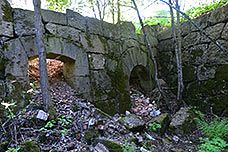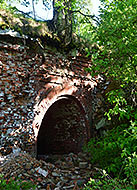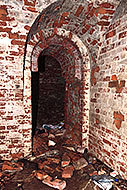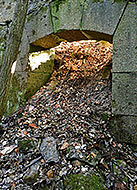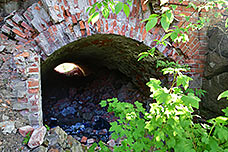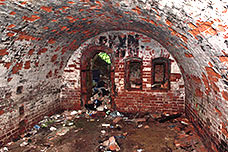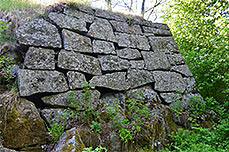Trångsund Fortress
Trångsund in Swedish means a narrow strait. From sea you can get to Vyborg by three straits, of which the most convenient is Trångsund. At the narrowest point of it between the islands of Ravansari and Uuransari, its width is only about 180 m. The remaining two straits - Pilsky and Niemelsky are more narrower and longer and, if necessary, can be easily blocked with stones. A small village of fishermen and pilots existed here under the Swedes.
Reports about first fortifications of Trångsund dated back to 1710 (Apraksin's letter to Peter I about artillery batteries on the islands in a convenient location), but it's hard not to admit that these considerations were not alien to the Swedes either. Traces of Peter's and the earlier Swedish fortifications were not found, apparently they were destroyed by later fortification construction.
The guns of Trångsund were ready to meet the enemy in the memorable year 1793, when the Swedish fleet was blocked on the Trångsund road for a month, but the Swedes did not reach these places.
During the Finnland's War of 1808-1810, in addition to the four existing batteries, six more were added to protect the straits. After that war, Vyborg was an important naval fortress in Finland, but little attention was paid to the modernization of it's naval front. Everything changed after the Crimean (Eastern) War, when the Allied Fleet stood abeam of Krasnaya Gorka near Kronstadt and sent out small detachments of ships on cruising raids to intercept Russian merchant ships and devastate the Finnish coast.
At the end of June 1855, three small Allied detachments undertook a sea raid on Vyborg. Only one of them under cpt. Elverton reached Trångsund, which by that time had only a few field batteries. They managed to pass the Trångsund Strait proper and at Nikolaevsky (Turkinsaari) island on July 1they engaged with the rowing gunboats of the Russian skerry fleet. The brutal firefight lasted half a day until dark without result for any side. The allies cruised in the Vyborg Bay until July 3, after which they went back to Kronstadt.
In 1864-67 a new powerful fortification was erected on the northern tip of Trångsund Island - a pentagonal redoubt with three artillery batteries, powder magazines, underground barracks-shelters - all according to the latest word of fortification science. In the 1870s, new rifled guns of the 1877 model were installed on the redoubt, the ramparts and vaults were strengthened, a new road was made from the redoubt to the pier.
By the 1880s the rapid development of rifled artillery made these fortifications obsolete. In 1893 the redoubt was disarmed, the cannons were sent to the Libava fortress. In the First World War Trångsund as a fortress did not participate. During the modernization of the Trångsund position of the Vyborg fortress in the 1910s the redoubt remained in its original shape, so now we have the opportunity to see a rare example of Russian fortification architecture of the 1860s-70s.
In 1918 the former Vyborg province became part of independent Finland, the city of Trångsund turned into the rapidly developing port city of Uuras. There is no information about the use of the fortress by the Finnish mlitary in the interwar period. Fierce fighting is reported on the old fortifications in March 1940 at the very end of the Winter War.
In 1947 the city of Trongzund was renamed Petroostrov, and in 1948 it was renamed Vysotsk, in honor of the machine gunner Kuzma Vysotsky, who was killed in action at the islands of the Vyborg Bay in March 1940. Vysotsk was a closed city until the very end of Soviet power. The military used the casemates of the fortress as warehouses.
Today the fortress is completely abandoned and represents a romantic ruin on the banks of the Trångsund Strait. The problem, as usual in this country, is in bureaucratic confusion - it is not clear whose object is federal or regional, and lack of money.
Travel experiences
Useless ruins overgrown with forest and bushes, witnesses of long-gone glory. There is a certain air romance here, combined with majestic views of the surrounding Karelia nature. It is worth a visit, there is a road and even a bus connection with the city of Vyborg. In addition, the entrance to the fortress is absolute free, and in our time of crisis and COVID, this is also an important moment.
Under certain circumstances, these ruins could have turned out to be a nice tourist attraction with cozy cafe, walking paths, small museums, a summer theater, a mini-hotel, a rental of pleasure boats and a fear room in dark dungeons. But now the circumstances in this country are uncertain, so the fortress is abandoned and ruined...
Land forts and fortress:
Bip Castle Gatchina Ivangorod Izborsk Kexholm Kirillov Monastery Koporye Novgorod Pechorskiy Monastery Peter&Paul Fortress Porkhov Pskov Schlisselburg Staraya Ladoga Tikhvin Vyborg Hameenlinna Hamina Kastelholm Kymenlinna Lappaenranta Raseborg Castle Savonlinna Tavetti Turku Visby Fredrikstadt Fredriksten Hegra Fort Hoytorp Fort Arensburg Narva Tallinn Antipatris Caesarea Jerusalem Latrun Fort Masada
Sea forts and fortresses:
Alexander Fort Ino Fort Krasnaya Gorka Fort Kronstadt: Kotlin isl. Kronstadt: North Forts Kronstadt: South Forts Trongsund Hanko Svartholm Sveaborg Marstrand Siaro Fort Vaxholm Oscarsborg
Artillery batteries and individual guns:
Coastal Artillery Hemso Fort
Fortified areas and defensive lines:
Karelian Fortified Area (KaUR) KrUR Leningrad Mannerheim Line Nevsky Bridgehead VT Line Harparskog Line Salpa Line Gothland
Russian
S e a r c h All news


